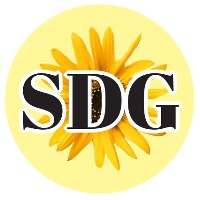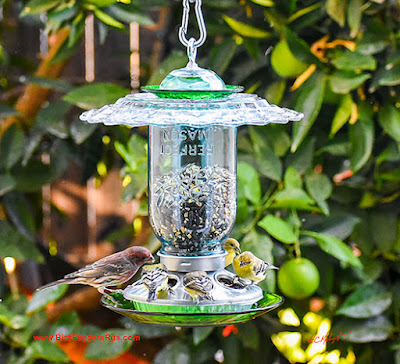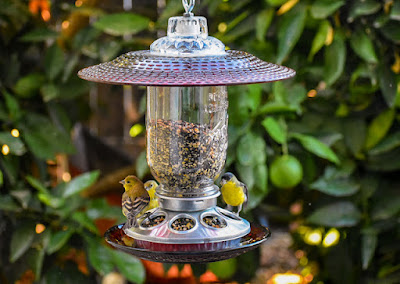
See stunning glass birdfeeders at annual Gardener's Market at Shepard Center

|
|
Mason jars and vintage glass are the main components of
Harold Malmquist's stunning birdfeeders. (Photos courtesy
BirdfeedersRUs)
|
A stash of antique glass became inspiration for a Folsom bird lover. Now, he creates beautiful birdfeeders that have won national acclaim.
Creator Harold Malmquist and his BirdfeedersRUs will be one of the featured vendors at the 17th annual Gardener’s Market, on Saturday, March 12, at Shepard Garden and Arts Center in McKinley Park. It’s one of the first opportunities for local patrons to meet the craftsman and purchase one of his handmade feeders since his finch feeder was named best by Birds & Blooms magazine.
Capped with brightly hued vintage glass, the feeders are distinctive. A mason jar serves as the feed holder, attached to a durable metal feeder. Several feeders also have a plate attached to the bottom, acting as a little extra lip for birds to perch.
And birds like it. They see the food in the clear-jar feed holder and quickly make themselves at home.
In his own yard, Malmquist has watched a wide range of birds frequent his feeders including all sorts of finches, sparrows, towhees, doves and nuthatches. He travels with his birdfeeders, too.
“We’re RVers,” he added. “We like to feed birds wherever we go and this design travels well.”
In addition, Malmquist developed a line of pretty hummingbird feeders, each topped with a vintage glass hood.
Although their antique glass decoration looks delicate, these birdfeeders are actually pretty rugged. They can withstand constant visits from feathered friends, and the glass-plate tops seem to be an obstacle for squirrels. (Another plus!)
A traveling salesman with a large West Coast territory, Malmquist collects more glass from estate sales, thrift shops and antique stores up and down the coast. His inventory now includes dozens of popular patterns and a rainbow of colors from cobalt blue to ruby red. Pale blues, soft greens and petal pinks are part of his enchanting pastel collection.
“I’m constantly buying glass,” he said. “They’re not making more antique glass.”
Malmquist’s birdfeeder business started seven years ago with inherited boxes of old glass plates and bowls. He started by making yard art – whimsical glass flowers and sculptures – for his Folsom garden, then branched out to birdfeeders. He tested his designs in his backyard for sturdiness as well as avian appeal.
As they have since his first introduction, birds enthusiastically flock to his feeders and voice their approval.
“I keep the garage door open while I work so I can hear their symphony,” he said. “I do this for the love of the birds.”
When he introduced his creations on Etsy, the birdfeeders just took off. So far, he’s sold more than 3,000, originally under the name Yankee Glass Art and now BirdfeedersRUs.
“And all 3,000 are field tested,” he said. “The design works.”
His feeders are priced from $29.95 and up, depending on the size and glassware used. His hummingbird feeders range from $28 to $65. With antique glass top and bottom, his top-rated finch feeder sells for $89. See more at https://birdfeedersrus.com/ .

|
|
Malmquist's elegant finch feeder is top-rated.
|
Did he ever think he could turn old glass into a bird-friendly business? “Never in a million years,” he said.
Malmquist has been approached about expansion into chain stores or other websites, but he’s declined. “To meet those needs, there’s too much volume,” he said. “It would take the fun out of it. I do this for love.”
Meet Malmquist and see his feeders during the Gardener’s Market from 9 a.m. to 3 p.m. Saturday, March 12, at Shepard Center, 3330 McKinley Blvd., Sacramento, in McKinley Park. Admission and parking are free for this event, presented by the Sacramento Perennial Plant Club.
Can’t make it Saturday? BirdfeedersRUs will return to Shepard Center on April 30 for the Sacramento Rose Society show and sale.
Comments
0 comments have been posted.Sacramento Digs Gardening to your inbox.
Food in My Back Yard Series
April 1: Don't be fooled by these garden myths
March 25: Fertilizer tips: How to 'feed' your vegetables for healthy growth
March 18: Time to give vegetable seedlings some more space
March 11: Ways to win the fight against weeds
March 4: Potatoes from the garden
Feb. 25: Plant a fruit tree now -- for later
Feb. 18: How to squeeze more food into less space
Feb. 11: When to plant? Consider staggering your transplants
Feb. 4: Starting in seed starting
Sites We Like
Garden Checklist for week of March 30
Your garden doesn’t mind April showers. Get busy now to enjoy those future flowers.
* Get ready to swing into action in the vegetable garden. As nights warm up over 50 degrees, start setting out tomato, pepper and eggplant transplants.
* From seed, plant beans, beets, cantaloupes, carrots, corn, cucumbers, melons, pumpkins, radishes and squash. (Soak beet seeds overnight in water for better germination,)
* Plant onion sets.
* In the flower garden, plant seeds for asters, cosmos, celosia, marigolds, salvia, sunflowers and zinnias.
* Transplant petunias, zinnias, geraniums and other summer bloomers.
* Plant perennials and dahlia tubers for summer bloom.
* Transplant lettuce and cabbage seedlings.
* April is the last chance to plant citrus trees such as dwarf orange, lemon and kumquat. These trees also look good in landscaping and provide fresh fruit in winter.
* Smell orange blossoms? Feed citrus trees with a low dose of balanced fertilizer (such as 10-10-10) during bloom to help set fruit. Keep an eye out for ants.
* Apply slow-release fertilizer to the lawn.